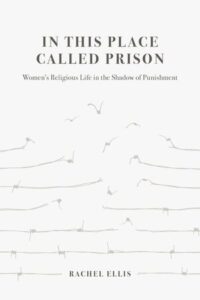
In This Place Called Prison offers a vivid account of religious life within an institution designed to punish. Rachel Ellis conducted a year of ethnographic fieldwork inside a U.S. state women’s prison, talking with hundreds of incarcerated women, staff, and volunteers. Through their stories, Ellis shows how women draw on religion to navigate lived experiences of carceral control. A trenchant study of religion colliding and colluding with the state in an enduring tension between freedom and constraint, this book speaks to the quest for dignity and light against the backdrop of mass incarceration, state surveillance, and American inequality.
Rachel Ellis is Assistant Professor of Criminology and Criminal Justice at the University of Maryland.
Why study religious life in prisons?
We think of prisons in the United States as secular institutions. We imagine that religion has no place in state-sponsored punishment. I wrote this book to challenge those assumptions—to show that religion plays a central role in the experience of punishment for many incarcerated people. For one, historians tell us that religious leaders and reformers played a key role in shaping incarceration as we know it. In the 18th and 19th centuries, theologies of penitence and moral transformation guided the purposes and practices of prison punishment.
Today’s prisons may have shifted away from their religious origins, but religious freedom remains a hard-won constitutional protection among incarcerated people. Anyone confined to a jail or prison has the right to practice their faith tradition. In fact, religious activities are among the most well-attended programs inside prison walls. While shrinking state budgets have cut funding for secular programs, religious activities remain readily available. They are primarily staffed by volunteer clergy and religious leaders from congregations on the outside. At Mapleside Prison*, where I did my research, about half of all women participated in a religious program, which outnumbered participation in the most popular secular program more than tenfold. For these reasons, and as I explore in greater depth in the book, religion is alive and well in contemporary U.S. prisons.
How does religion shape the prison experience?
A research participant named Estrella explained the role of religion in her incarceration: “For me, it was front and center. That’s how I did my time. It governs so much.” In my study, incarcerated women who participated in religious activities found that religion offered a competing set of norms, practices, and values with the potential to displace the norms, practices, and values of prison and undermine its coercive aims. Religion was a resource for dignity, humanity, and social support. Scriptural study sessions and faith-based self-help groups fostered a sense of community. Clergy and religious leaders who volunteered their time offered emotional support and a listening ear to women who otherwise felt judged or forgotten. As the full-time chaplain at Mapleside described her perspective, “I look and see a woman who God loves. I don’t see a ‘criminal.’” In these ways, religion redefined key aspects of the meaning and social experience of incarceration.
Religion was a resource for dignity, humanity, and social support.
Rachel Ellis
How does gender matter for the story?
Women’s incarceration is understudied, even though women account for 7% of the total prison population, according to data from the Bureau of Justice Statistics. While men’s incarceration rates have begun to decline for the first time since the prison boom of the 1970s and 1980s, women’s incarceration rates remain elevated.
There are important reasons to believe gender shapes the prison experience, from women’s “pathways to incarceration” identified by feminist criminologists to the different needs of women in prison compared to men. In the book, I examine the competing messages offered by the prison system and religious leaders regarding gender expression, marriage, and motherhood. The women I met adopted, adapted, rejected, and reflected these normative expectations around what it meant to be a woman or a mother in prison. Each of these gendered messages intersected with ideas around race, ethnicity, and sexual orientation, at times replicating gender essentialist views steeped in harmful stereotypes, and at other times, challenging them.
What’s one key takeaway you hope readers understand after reading your book?
In This Place Called Prison explores religion’s capacity to offer both freedom from carceral control and constraint within carceral control. In the book, I propose a concept called secondhand carcerality. Secondhand carcerality is a reiteration of carceral control by a non-carceral actor that occurs via contact with the criminal justice system. Secondhand implies an indirect manifestation, an unavoidable and even unintentional reissuing of a primary force by a subordinate but ostensibly separate force. Using religion as a case study, I found that even well-intentioned institutional actors take on punitive logics when they interact with the surveillance, regulation, and coercion of the intractable prison system. Criminologists and sociologists have written about the ways that prison harms individuals, families, and communities beyond the punishment itself. Secondhand carcerality is an interactional, on-the-ground mechanism of how such harms can be perpetuated among institutions that work inside, alongside, or adjacent to prisons.
How did you get access to a prison for an ethnographic study?
It involved a lot of paperwork, a big investment of time, and many months of uncertainty. First, my project underwent careful examination by my university’s Institutional Review Board. Once the IRB approved my project, I submitted a research proposal to the state Department of Corrections’ own research board. The D.O.C. research board required multiple rounds of revisions. For more than half a year, I got the sense that it was not only my proposal under scrutiny, but also my legitimacy as a researcher. Having a university affiliation and IRB approval helped, but it seemed like correctional administrators wanted to make sure I was not planning to write an exposé. Once granted permission, the even more important work of building trust with incarcerated women began. Alongside a careful process of ongoing informed consent, it was my job to listen and to do their stories justice. In the Methodological Appendix to this book, I describe the process of getting access in greater detail, with special attention to positionality, rapport, and the ethics of conducting a prison ethnography.
* All names of people and places are pseudonyms to protect confidentiality.
Learn more about the book In This Place Called Prison by Rachel Ellis.
